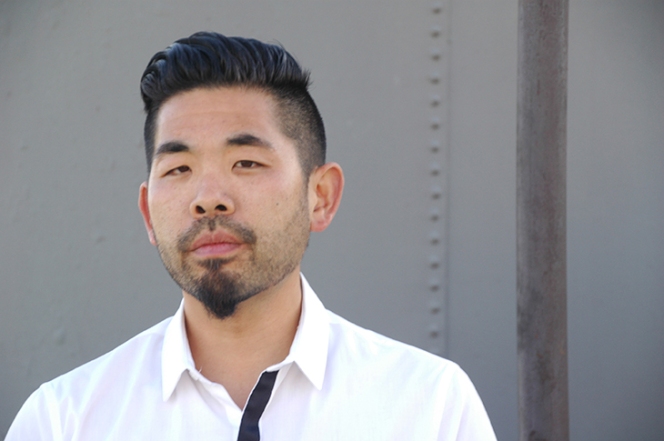Your Cart is Empty
Recent Articles
- Efficiency Meets Innovation: SketchUp 2024 Unveiled
- Maxon One Spring 2024 Release Packs Particle Power, Toon Shading, and More
- TurboCAD 2024 Unveiled by IMSI Design: Discover the New Features and Enhancements
- Exploring the Latest InfraWorks 2025 Updates
- Introducing the Latest Innovations in Autodesk's ReCap Pro 2025
- Discover the Latest Enhancements in Civil 3D 2025
- Exploring the Newest Features and Enhancements in Revit 2025
- Explore the Latest Features in Vantage 2.3 Update
- Explore the Latest AutoCAD 2025 Enhancements: Activity Insight, Smart Blocks, and Apple Silicon Support
- Unveiling Enscape 4.0: Revolutionizing Design with Unified Experience for macOS and Windows Users
ArchiTrek The Next Generation – Top 10 reasons to attend the ACADIA conference
November 14, 2014 14 min read
Editor's Note: To boldly go where no guest blogger has gone before, we teleported Architect Apollo Spiliotisto ACADAIA 2014. Here's the first entry on the Architect's Log, documenting his mission for Novedge. Stay tuned ……..
The views, opinions and positions expressed within guest posts are those of the author alone and do not represent those of Novedge.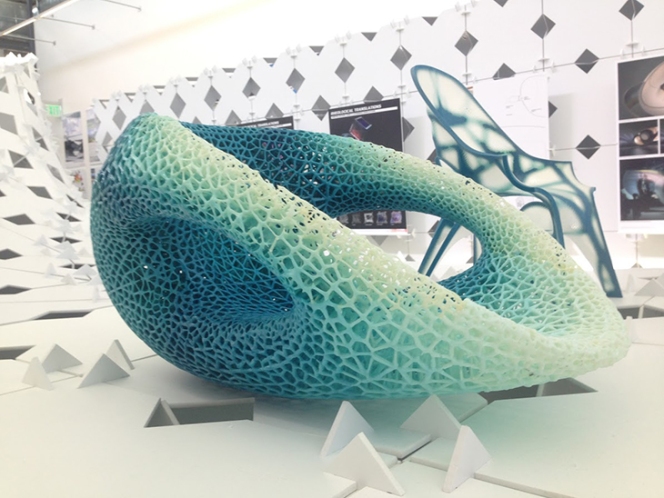
In our era of digital abundance, the way we approach design is changing fundamentally. It’s no longer a novelty in our profession, but a process that defines our expanding realm of architectural exploration that can inform our design intent, while embracing constraints, iteration and user-input in the creative practice. Through intense workshops, paradigm-shifting conversations and enlightening lectures, the ACADIA 2014 conference strived to expose the bleeding edge of contemporary computational design + aesthetics in the “post-digital” age.
Coming down from the high of this year’s ACADIA conference took a few days of recovery and reflection, as it was an electrifying experience of creativity, applied research and knowledge exchange with some of the leading experts of the field, concluding with a design “Hackathon” that had the participants firing enough neurons to power the entire campus. 
The conference gathered an international crowd of over 550 architectural explorers, focusing on computational design through experimental research of generative modeling techniques, robotic fabrication, emerging design technologies and creative coding. New paradigms of computing, experimental practice and innovative ways of design thinking were presented, all challenging the conventional methods in which architecture is generated and experienced. The Association for Computer-Aided Design in Architecture (ACADIA) is all about delving into the intricacies of design through research and education, while striving to promote the importance of enhancing computers and technology for the fields of architecture, planning and building science. Instead of a protracted day-by-day report of the presentations and events, which presented state-of-the-art research and applications in their relative branch of computational design, I thought it would be more useful to list some of the best reasons anyone excited by design should attend the conference. Here it goes :
Instead of a protracted day-by-day report of the presentations and events, which presented state-of-the-art research and applications in their relative branch of computational design, I thought it would be more useful to list some of the best reasons anyone excited by design should attend the conference. Here it goes :
1. Travel to acclaimed universities
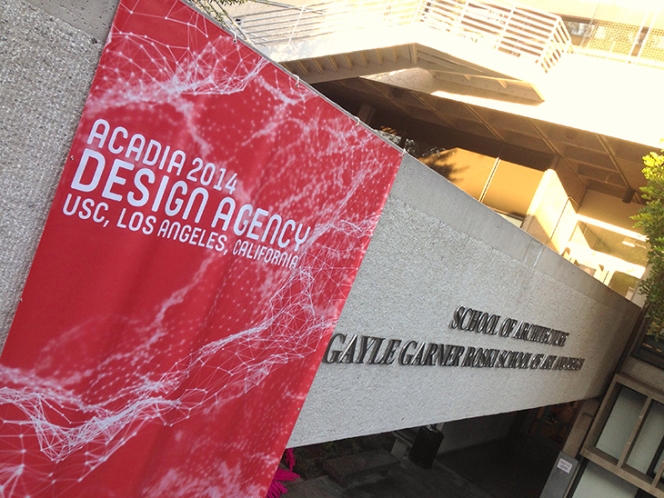

Each year, the ACADIA conference is held at an esteemed university in North America, bringing together an international crowd of top researchers, educators and professionals who are experts in their respective field, to attend exhibitions, specialist workshops and lectures related to the conference theme. This year the University of South California (go Trojans!) in L.A. hosted the events, assembling a stellar group of speakers showing their work at the intersection of computer science, engineering, gaming, interaction design, and behavioral sciences.//player.vimeo.com/video/109673352?title=0&byline=0&portrait=0
Acadia 2014, Los Angeles, Main Titles from Isohale on Vimeo.
2. Dive into the deep-end with intense design workshops

Images courtesy of ACADIA
Ten intense computational design workshops in the three days leading up to the conference laid the ground-work for some of the themes explored during the conference.
From swarm intelligence with algorithmic design strategies with Grasshopper + Rhino + Processing, enhanced parametric design & analysis with Dynamo + Vasari, complex fabrication processes with robotic arms via graphical programming in Grasshopper, interactive form-finding with physics using Kangaroo through Grasshopper, as well as data-rich-driven form exploration for amphitheater bowl design with Ladybug through Grasshopper, while validating the design with the Unity game engine through an Oculus Rift. Extensive details on the workshops can be found on the conference site.
3. Witness and discuss cutting edge international research
Explore the diverse microcosms of the computational design world through paper presentations ranging from multi-agent systems, computational physics simulation, advanced manufacturing, big data, swarms, biomimetic patterns, adaptive structures, pneumatic 3D printing & programmable matter from human to urban scale.
The first day of the conference focused on computational simulations and how they influence geometry exploration. Joshua Taronpresented informed multi-agent systems, playing with evaluative frameworks to create infinite iterations of programmable spaces through abstraction of built form. Claudia Ottenspoke about the “Everyone is an Architect”project where users are empowered to create their own home based on the their lifestyle preference, through the architect’s designed system. Giving the user guidelines, specified limitations but direct access, the design process can be informed to create endless architectural optimizations through generative algorithms. Finally, Jose Sanchez from the Plethora Project culminated the day’s concepts presenting his “Polyomino” and “Bloom” projects, which proposed a playful generative design process giving the user authorship of the equation. The Bloom pavilion showcased structures of hundreds to thousands of identical pieces that can be assembled by anyone, creating different intricate formations every time, while the project evolved into a social experiment on the use of game logic as a crowd-source medium of adaptation. The Polyomino project, part of the “Gaming to Making” series, engages crowd-sourced design with the use of gaming tools to create serial repetitious forms in combinatorics to discover new array configurations.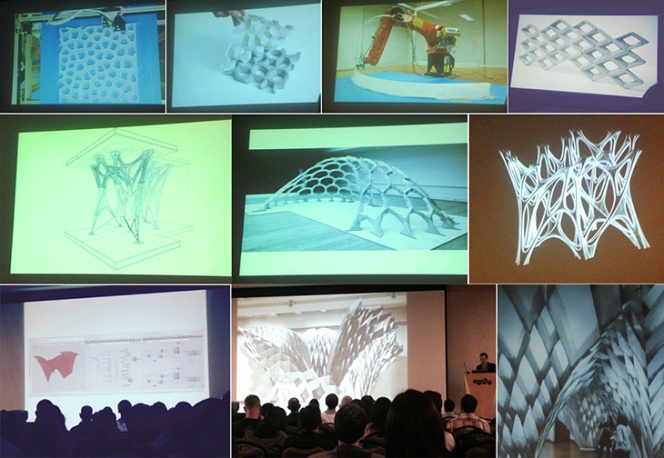 Friday started off with Alisa Andrasek (Principal of Biothing), who worked with Jose on the Bloom project, speaking about morphogenesis through biological processes, computational physics simulations to create algorithmic profiles of matter, as well as inviting us down the rabbit hole with her Biothing research where design is integrated with simulation. The speakers followed with more tangible concepts the next day, describing new fabrication methods and material research: from self-formation processes to create weaving patterns, analyzing gravity-formed sand piles, to the creation of 3d printable ceramic tiles for acoustic reverberation and absorption, using 3D printers as molds for concrete sculptures and elevate the practice to the scale of architecture, tectonic material studies of tensile concrete frameworks in the search for a self-organizing tensile grid for multi-story buildings, as well as examining the digital revival of gothic vaults.
Friday started off with Alisa Andrasek (Principal of Biothing), who worked with Jose on the Bloom project, speaking about morphogenesis through biological processes, computational physics simulations to create algorithmic profiles of matter, as well as inviting us down the rabbit hole with her Biothing research where design is integrated with simulation. The speakers followed with more tangible concepts the next day, describing new fabrication methods and material research: from self-formation processes to create weaving patterns, analyzing gravity-formed sand piles, to the creation of 3d printable ceramic tiles for acoustic reverberation and absorption, using 3D printers as molds for concrete sculptures and elevate the practice to the scale of architecture, tectonic material studies of tensile concrete frameworks in the search for a self-organizing tensile grid for multi-story buildings, as well as examining the digital revival of gothic vaults.
A really exciting part of the day was when Skylar Tibbitsproceeded to explain his investigations in materiality through the process of 4D printing, or programmable materials to be more specific, where time played a role in the design process and objects were designed to react to certain conditions. Either through chaotic self-assembly, or targeted material adaptation, predetermined shapes would form. Some examples of these concepts were shown, including floating balloons with magnets that would connect and disconnect with each-other as they moved around the space, research into air flow flaps in airplanes that could replace mechanical parts as they altered form based on external temperature changes, and a favorite of the crowd, an Eames Elephant toy prototype that self-assembled and folded without any mechanical means from a flat surface into the well-known shape in 3D.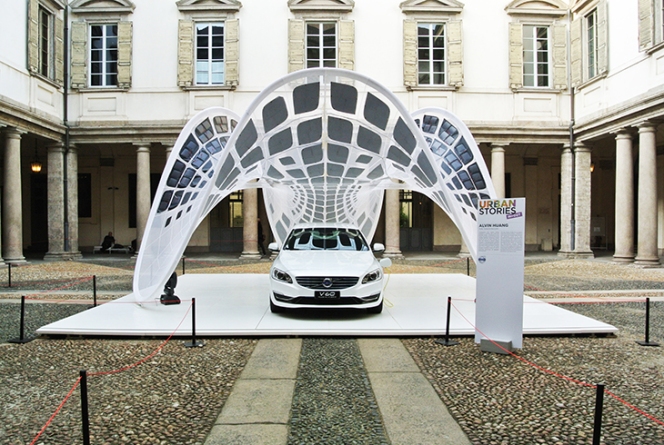 Alvin Huang also presented his studio’s design process on creating the Pure Tensile Pavilion for Volvo V60 hybrid car charging station. The structure is covered in solar panels to charge the car, and is so portable it can be folded up to fit in the boot of the car. The aluminium frame is constructed from 24 CNC-bent sections, covered in a vinyl encapsulated polyester mesh membrane tensioned skin. It can be erected or dismantled in less than an hour by 2-3 people. Alvin explained in great detail how his team used Rhino, Grasshopper, Kangaroo and Ladybug to simulate and optimize the shape as well as distribute the 252 solar panels throughout the structure to maximize their exposure to the sun.
Alvin Huang also presented his studio’s design process on creating the Pure Tensile Pavilion for Volvo V60 hybrid car charging station. The structure is covered in solar panels to charge the car, and is so portable it can be folded up to fit in the boot of the car. The aluminium frame is constructed from 24 CNC-bent sections, covered in a vinyl encapsulated polyester mesh membrane tensioned skin. It can be erected or dismantled in less than an hour by 2-3 people. Alvin explained in great detail how his team used Rhino, Grasshopper, Kangaroo and Ladybug to simulate and optimize the shape as well as distribute the 252 solar panels throughout the structure to maximize their exposure to the sun.
 The final day of the conference explored a mixture of the previous days’ concepts, with the focus on channeling the designs and merging both digital and physical worlds. Starting off with adaptive pneumatic envelope assemblies through cellular aggregation systems, casting 3D printed non-repetitive / adaptive curved composite surfaces, and adaptive tent structures for multi-functional spaces.
The final day of the conference explored a mixture of the previous days’ concepts, with the focus on channeling the designs and merging both digital and physical worlds. Starting off with adaptive pneumatic envelope assemblies through cellular aggregation systems, casting 3D printed non-repetitive / adaptive curved composite surfaces, and adaptive tent structures for multi-functional spaces.
Then the talks took a sharp turn towards more science fiction related topics, such as “the technological singularity”, where the progress of technological innovation, computing power and artificial intelligence is predicted to outpace human intelligence and we will then merge with computers or the machines take over (a.k.a. “The Matrix”). Not explored into such depth of depressing scenarios, but the discussion was more on the architectural uses for the digital techniques and the connections between the analog and digital worlds, through Augmented Reality, sense-based interactions and seamlessly merging the environments through Google Glass, Oculus Rift, or even just the smartphone.
Guvenc Ozelshowed off his “Project Source Code” which he exhibited at the Venice Biennale, using smartphones to essentially “hack” one of the exhibitions, uncovering layers of hidden animated objects floating in space through the display, giving the users a choice to experience the reality they wanted to see.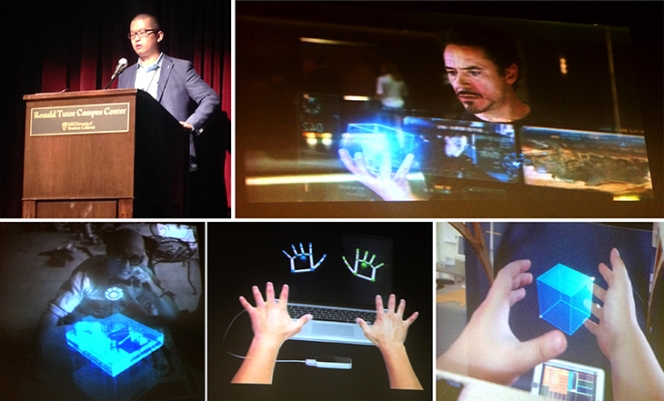 Teng Teng followed exploring the Iron Man 3D holographic user interface and bringing it to reality using a combination of the Leap Motion and a projector to create a virtual 3D interactive display system with coordinated feedback. He described the frustration of architects in our three-dimensional digitally infused world, that we are still limited by two-dimensional input systems like the keyboard, mouse and flat display. Intuitive hand gestures are translated into interaction commands that allow real-world-like object modeling and manipulation. Draw polylines with your finger using your thumb to create points or extrude a shape by pulling a flat surface apart, and (probably my favorite) use a virtual laser wire cutter – with two fingers pointing at each other – to slice a shape in two. One could easily see this system be coupled with virtual/augmented reality to create a “design environment” not unlike the one in Bruce Brandt’s short film World Builder. //player.vimeo.com/video/3365942?title=0&byline=0&portrait=0&color=f0bc00
Teng Teng followed exploring the Iron Man 3D holographic user interface and bringing it to reality using a combination of the Leap Motion and a projector to create a virtual 3D interactive display system with coordinated feedback. He described the frustration of architects in our three-dimensional digitally infused world, that we are still limited by two-dimensional input systems like the keyboard, mouse and flat display. Intuitive hand gestures are translated into interaction commands that allow real-world-like object modeling and manipulation. Draw polylines with your finger using your thumb to create points or extrude a shape by pulling a flat surface apart, and (probably my favorite) use a virtual laser wire cutter – with two fingers pointing at each other – to slice a shape in two. One could easily see this system be coupled with virtual/augmented reality to create a “design environment” not unlike the one in Bruce Brandt’s short film World Builder. //player.vimeo.com/video/3365942?title=0&byline=0&portrait=0&color=f0bc00
World Builder from BranitVFX on Vimeo.
4. Attend keynote addresses from celebrated luminaries

Images courtesy of ACADIA.
An all-star lineup of keynote speakers drew the crowds exhibiting their paradigm-shifting work on pushing the boundaries of computational design.
Among them the inventor of SimCity, the Sims and Spore, Will Wright showed off his humble beginnings as an architect in the early days of personal computing, bringing a futurist’s urban simulation gaming adventure closer to our current reality, where computers influence and intersect with the real world. The inspirational Neil Gershenfeld, professor of the MIT Media Lab, and Director of “The Center for Bits and Atoms” explored the emergence of the FAB LAB, a platform for learning and innovation, celebrating the era of the “maker movement” and inspiring local cultures to facilitate self-sufficiency through access to global knowledge and useful tools as well as concepts such as distributed manufacturing.
Jenny Sabinalso gave her award talk, accepting the Award of Excellence for Digital Practice, filling the room with many standing, eager to see the extensive research that is truly at the intersection between architecture and science. Her studio and research lab apply theories and insights from biology, mathematics to the intricate design of complex material structures including, among many projects presented, the "myThread Pavilion" commissioned by Nike where adaptive knitted threads form tubed structures between aluminium rings to create a web of photoluminescent Voronoi clouds.  Images from Jenny Sabin Studio.
Images from Jenny Sabin Studio.
David Gerber, one of this year's ACADIA's co-chairs and Assistant Professor at USC, launched his book "Paradigms in Computing" during a panel discussion on the status of contemporary digital design in the architecture and general design fields, illustrating critical, theoretical and practical research, and exploring our computational reality through the convergence of our physical and cyber world while debating the notions of Design Agency. 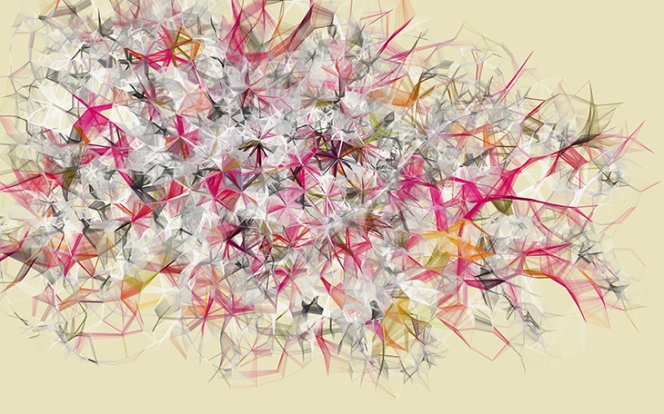 Such an illustrious roster of speakers seemed it could only be followed by a recognized behemoth in computational design, Casey Reas. Along with his famous digitally created artwork he's also very well known for co-creating one of the top open-source programs back in his M.I.T. days, "Processing", a programming language and development environment that has been a game-changer in the field of visual design and computationally-derived art and architecture. Despite its extreme popularity and power, Reas is a down-to-earth person, very easy to talk to and remains a true artist focused on his craft and an evangelist of computational design explaining: "Programming is not a technical discipline but a tool for thinking."
Such an illustrious roster of speakers seemed it could only be followed by a recognized behemoth in computational design, Casey Reas. Along with his famous digitally created artwork he's also very well known for co-creating one of the top open-source programs back in his M.I.T. days, "Processing", a programming language and development environment that has been a game-changer in the field of visual design and computationally-derived art and architecture. Despite its extreme popularity and power, Reas is a down-to-earth person, very easy to talk to and remains a true artist focused on his craft and an evangelist of computational design explaining: "Programming is not a technical discipline but a tool for thinking."
5. Hang out with scholars and experts in diverse fields

This was my first time attending an ACADIA conference, but most definitely will not be the last. Along with meeting some of the field’s most innovative researchers and designers, I had the great honor and opportunity of interviewing two of the conference’s co-chairs, Alvin Huang AIA (founder of Synthesis Design + Architecture & tenure-track Professor at the USC School of Architecture) and Jose Sanchez (Architect/Programmer/Game Designer, founder of the Plethora-Project& tenure-track Assistant Professor at the USC School of Architecture). I also had the chance to have a long chat with the multi-talented architect Jenny Wu about her collection of 3D-printed jewelry on display in the architecture school’s exhibition along with Alvin and Jose’s marvelous 3D-printed creations. Stay tuned to the Novedge Blog for their takes on the future of digital design & fabrication, programmable matter, democratization of design authorship, along with collective intelligence & interactive design interfaces through video games in the age of the Maker movement, and the impact additive manufacturing is having in the worlds of architecture as well as fashion.
6. See a rockStarchitect entertain an admiring swarm of fans
Standing in line for Zaha Hadid’s keynote at the Bovard Auditorium felt more like waiting for a rock-star to appear, or sort of like being in the queue for a Cronut on Spring Street; the swarms of people lining up to get in, with another stand-by line on the side, truly baffled others strolling around the university campus, asking us if the Foo Fighters were playing tonight or if they were giving out free iPads in there. Qingyun Ma, Dean of the USC School of Architecture, introduced Zaha Hadid on the stage: “Zaha is the most provocative architect on the planet,”. She light-heartedly asked the audience “is Frank Gehry here?”. Hadid was much more entertaining than her solemn façade may portray, cracking jokes about Frank Gehry, sharing fun anecdotes of her projects, and giving gentle jabs to David Gerber , to whom she made clear she was attending as a personal favor (the 5 years of badgering clearly worked ).
Qingyun Ma, Dean of the USC School of Architecture, introduced Zaha Hadid on the stage: “Zaha is the most provocative architect on the planet,”. She light-heartedly asked the audience “is Frank Gehry here?”. Hadid was much more entertaining than her solemn façade may portray, cracking jokes about Frank Gehry, sharing fun anecdotes of her projects, and giving gentle jabs to David Gerber , to whom she made clear she was attending as a personal favor (the 5 years of badgering clearly worked ).
For the first half of her trip down memory lane, Zaha presented her decades of projects, starting from the early work from her Malevich drawings, from her thesis to current day in a certain nostalgic manner, speaking of the early structures as landmasses, rocks, streams or rivers. Progressing through her built work timeline, the designs became more streamlined forms: from tensile fabric structures, to a funky Russian private “bachelor pad”. Her timeline ended with a story about the Tokyo stadium. Zaha joked that “the architects were having a wonderful time with the project”. 
Zaha Hadid's drawing. Image from Lebbeus Woods blog.
Seeing all the projects progress over time, it was very evident her work was eventually enabled from the advancements in digital design and computation, from concepts and designs thought up decades before they became reality. A big shock to probably most of the audience was her revelation that she used to “ban using computers in the office”, but now admits that they “add another layer to the work”. It seems quite ludicrous that a company now recognized for sleek sexy curvy designs and which continuously pushes the boundaries of engineering and generative design could do any of that without the use of computers!
During the night, Zaha was also awarded the first Lifetime achievement award by the 2014 ACADIA president. Hadid and her partner at Zaha Hadid Architects, Patrick Schumacher, then casually sat on some Barcelona-like chairs to take some questions from the crowd. Two of the most memorable ones were :
“Did Gaudi inspire you in any way?”….to which Zaha resentfully joked : “I have no inspiration at all” ; and “…why do you always wear black?” Her answer : “I like black..…when I was young up until around 8 years old I wore bright colors, … but since then it’s been black”. No one could tell if she was really joking or not, but the stereotypical trend of architects feeling more comfortable in black garments lives on, as contemporary followers uphold the tradition of the uniform that can only be explained as being the color of elegance, rebelliousness, and perfection. That, or we just look hot in black.
7. Exhibitions – get up close to monuments of digital craft

Strolling around School of Architecture, I came upon several exhibitions in Watt Hall and the Harris Courtyard, including 3D printed pieces from Alvin Huang, Zaha Hadid, and Jose Sanchez among others. I was surrounded by about 70 peer-reviewed posters of projects that most people would associate with science fiction or Hollywood film. The Tex-Fab digital fabrication "Plasticity" competition's finalists presented their full-scale models in the courtyard, along with a couple of interactive installations in adjoining rooms. 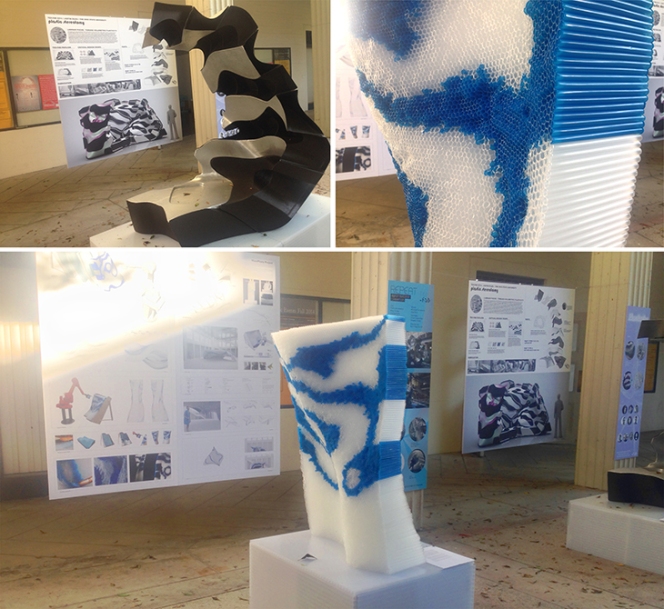
8. Architecturally inspired treats
From dinners to parties on rooftops and the final evening banquet, the ACADIA organizers were very thoughtful in setting up some great food & drinks after the intense days of workshops and presentations. These were great opportunities where the attendees could mingle with each other, exchange ideas and network. It was very surreal meeting so many experts in different fields, and I think everyone enjoyed the informality of the lunches and dinners, making everyone very approachable and chatty.
My most notable treat at the conference was one of my favorite ice-creams: Coolhaus ice-cream. Architecturally-inspired cookie-ice-cream sandwiches, with names like: the "Rem Coolhaus", the "Mintimalism", the"Lous Ba-Kahn", or the "Mies Vanilla Rohe". The choices were incredible, the ice-cream divine, and the Coolhaus guys were awesome. If you've never tasted it, check out the Coolhaus locations for your next road-trip. 
9. Hackathon
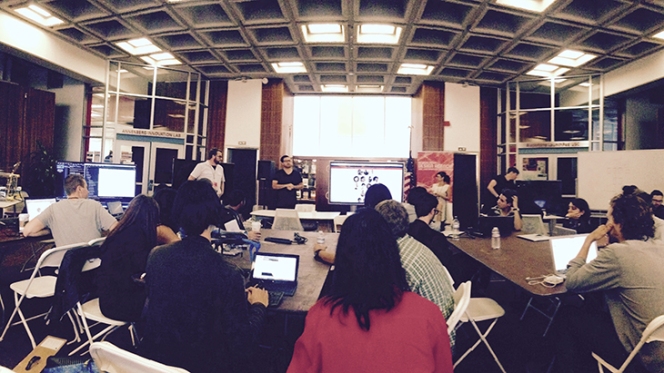
The closing event of ACADIA 2014 was The "Hackathon", an experimental gathering of design Jedis, programming Ninjas, visualization Wizards, but also for young Padawans eager to explore new realms of the architectural craft. The event was open to anyone from the conference, where every participant was encouraged to open their laptops and with the guidance of some ACADIA champions, co-work, experiment and share their tricks to produce something exciting related to the theme. Hosted at the Annenberg Innovation Lab at USC and powered by Unity3D, a plethora of applications and fascinating range of workflows immediately popped up around the room. 'Design Glitch’ ACADIA Hackathon hosted by the Annenberg Innovation Lab, Sponsored by Unity3D. Organized by Jose Sanchez, Kris Mun and Jason Kelly Johnson
'Design Glitch’ ACADIA Hackathon hosted by the Annenberg Innovation Lab, Sponsored by Unity3D. Organized by Jose Sanchez, Kris Mun and Jason Kelly Johnson
From 3DS Max, Softimage, Rhino, Grasshopper to Processing ( "Rhynamo"made its debut). One team even had a drone with humidity and CO2 sensors to give their model generative information from the area, and some cool guys from Zmorph showed up with one of their FDM printers, allowing the teams full access to 3D print their designs. All participants were encouraged to wander from team to team to absorb different techniques and once they found something exciting, they had the opportunity to join in on the action. The entire experience was a celebration of sharing and making, where no limits were placed upon crazy designs or moon-shot projects, and where the best ones got rewarded with prizes. I'll be writing more about the Hackathon at a later date, so stay tuned for all the geekery to ensue. 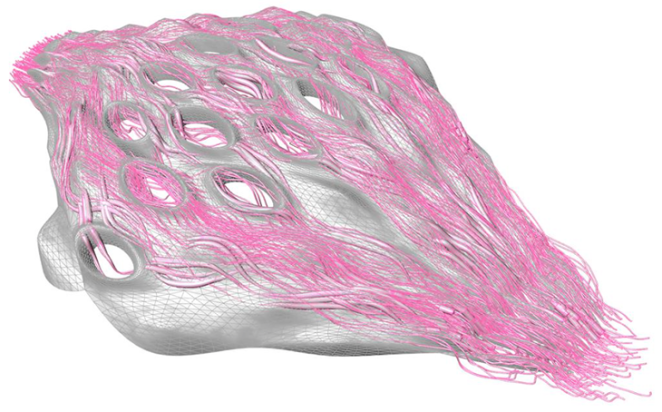
Image courtesy of Brian Ringley.
10. Listen to trippy music from a coding DJ

Music and Live Coding performance by Charlie Roberts.
During the second half of the Hackathon day, a special guest appeared. Jose Sanchez introduced him as DJ Charlie Roberts, a Live coding music performer. After he was hooked up to a large screen visible to everyone, Charlie began writing seemingly simplistic lines of code which flashed bright red, activating some musical loops at different tempos and frequencies, slowly becoming a symphony of melodies and then evolving into some psychedelic tunes that I’d like to believe aided the creative energy abundantly floating around in the room. Check out the video below, taken by Jose, giving you a sense of Charlie’s music and a quick peak into the Hackathon in progress.//player.vimeo.com/video/110960668
ACADIA HACKATHON from jomasan on Vimeo.
After all the mind-blowing things experienced throughout the conference, one thing became very clear: we are living in an immensely exciting time, where designers are harnessing the power of numerous matured and ever-growing innovative technologies, merging their potential to explore and push the boundaries of design. “The Next Generation” of Architecture seems to be fundamentally integrated with, if not essentially dependent on, new programming languages, data processing, and generative engineering (in addition to new fabrication techniques and materials). As coding has become a highly valuable asset in recent years, to the extent that 8-year-olds are learning Python script, it will become even more prevalent in the future, and it will be the duty of architects to at least understand, explore and adopt the new techniques and workflows as much as we have embraced technology and computing today.
Editor's Note: Apollo Spiliotis is a Project Architect at SubenDougherty in New York by day, and a technology writer, CG artist and 3D printing enthusiast by night. With an immense passion for technology and digital design, he loves sharing knowledge and developing his skills along the way. Having been published on industry websites and magazines, his fascination with 3D design led him to found archiCADmonkey.com, where he shares news, tutorials, tips & tricks, and interviews of luminaries from the design world. ch as distributed manufacturing.Connect with Apollo on Twitter and stay tuned for his next blog post on his ACADIA 2014's adventures.
Related articles
Also in NOVEDGE Blog

Maxon One Spring 2024 Release Packs Particle Power, Toon Shading, and More
April 10, 2024 4 min read
Read More
TurboCAD 2024 Unveiled by IMSI Design: Discover the New Features and Enhancements
April 10, 2024 2 min read
Read MoreSubscribe
Sign up to get the latest on sales, new releases and more …



